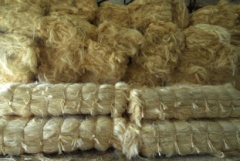Difference between revisions of "Sisal"
m |
|||
| Line 7: | Line 7: | ||
| risk factors = See text | | risk factors = See text | ||
}} | }} | ||
| + | __TOC__ | ||
==Description== | ==Description== | ||
Sisal (Agave sisalana) is an agave that yields a stiff ( white to yellow-white) fibre traditionally used in making twine, rope and also dartboards. The term may refer either to the plant or the fibre, depending on context. It is sometimes incorrectly referred to as sisal [[hemp]] because [[hemp]] was for centuries a major source for fibre, so other [[fibres]] were sometimes named after it.<br><br> | Sisal (Agave sisalana) is an agave that yields a stiff ( white to yellow-white) fibre traditionally used in making twine, rope and also dartboards. The term may refer either to the plant or the fibre, depending on context. It is sometimes incorrectly referred to as sisal [[hemp]] because [[hemp]] was for centuries a major source for fibre, so other [[fibres]] were sometimes named after it.<br><br> | ||
Revision as of 12:30, 7 August 2014
| Infobox on Sisal | |
|---|---|
| Example of Sisal |  |
| Facts | |
| Origin |
|
| Stowage factor (in m3/t) | 2,26 / 2,42 m3/t (bales |
| Humidity / moisture | 5-12% |
| Ventilation | - |
| Risk factors | See text |
Sisal
Contents
Description
Sisal (Agave sisalana) is an agave that yields a stiff ( white to yellow-white) fibre traditionally used in making twine, rope and also dartboards. The term may refer either to the plant or the fibre, depending on context. It is sometimes incorrectly referred to as sisal hemp because hemp was for centuries a major source for fibre, so other fibres were sometimes named after it.
Traditionally used for rope and twine, sisal has many uses, including paper, cloth, wall coverings and carpets.
Sisal plants consist of a rosette of sword-shaped leaves about 1.5 to 2 metres tall. Young leaves may have a few minute teeth along their margins, but lose them as they mature.
Propagation of sisal is generally by using bulbils produced from buds in the flower stalk or by suckers growing around the base of the plant, which are grown in nursery fields until large enough to be transplanted to their final position.
The sisal plant has a 7–10 year life-span and typically produces 200–250 commercially usable leaves. Each leaf contains an average of around 1000 fibres. The fibres account for only about 4% of the plant by weight. Sisal is considered a plant of the tropics and subtropics, since production benefits from temperatures above 25°C and sunshine.
Fibre is extracted by a process known as decortication, where leaves are crushed and beaten by a rotating wheel set with blunt knives, so that only fibres remain. In East Africa, where production is typically on large estates, the leaves are transported to a central decortication plant, where water is used to wash away the waste parts of the leaf. The fibre is then dried, brushed and baled for export. Superior quality sisal is found in East Africa. Proper drying is important as fibre quality depends largely on moisture content. Artificial drying has been found to result in generally better grades of fibre than sun drying, but is not feasible in the developing countries where sisal is produced. In the drier climate of north-east Brazil, sisal is mainly grown by smallholders and the fibre is extracted by teams using portable raspadors which do not use water. Fibre is subsequently cleaned by brushing. Dry fibres are machine combed and sorted into various grades, largely on the basis of the previous in-field separation of leaves into size groups.











